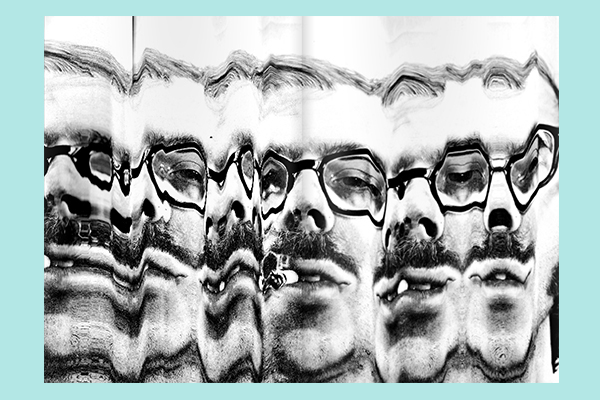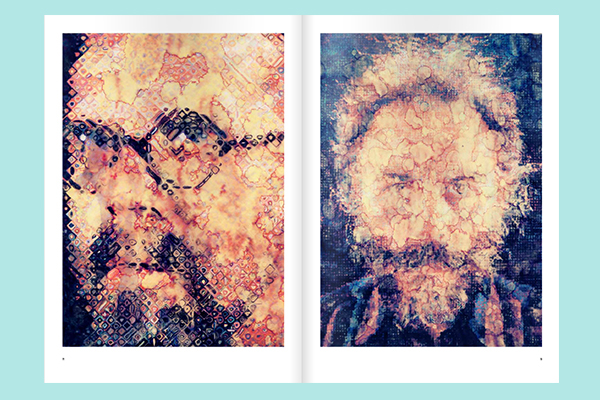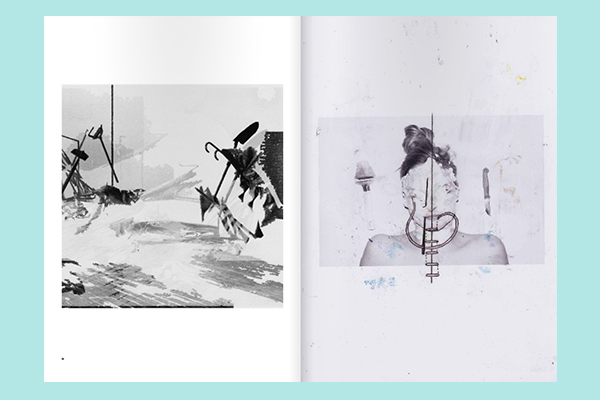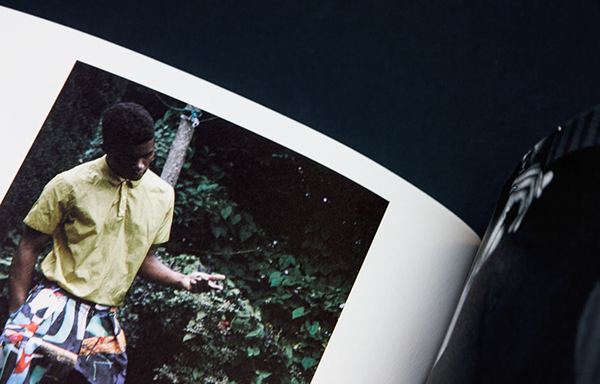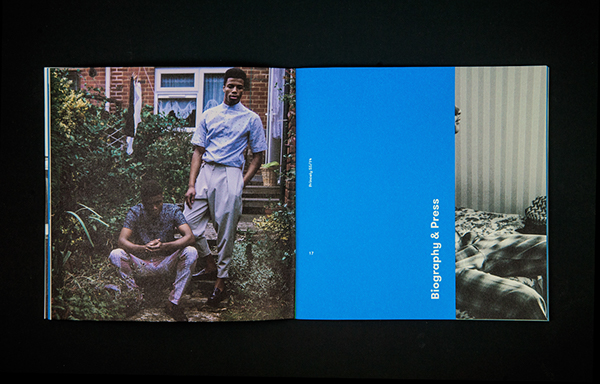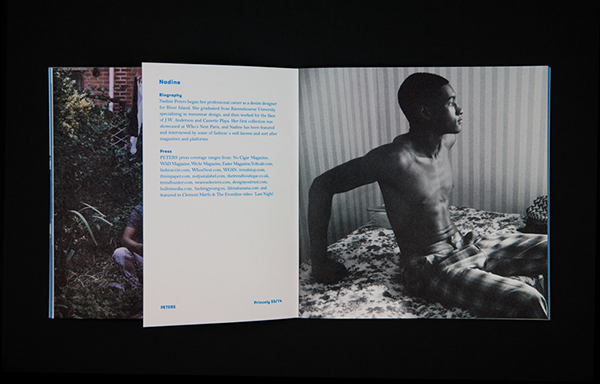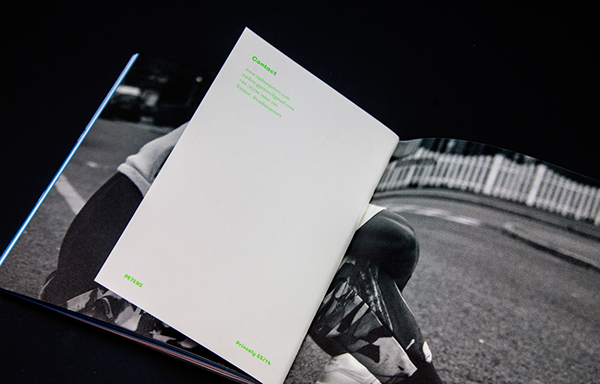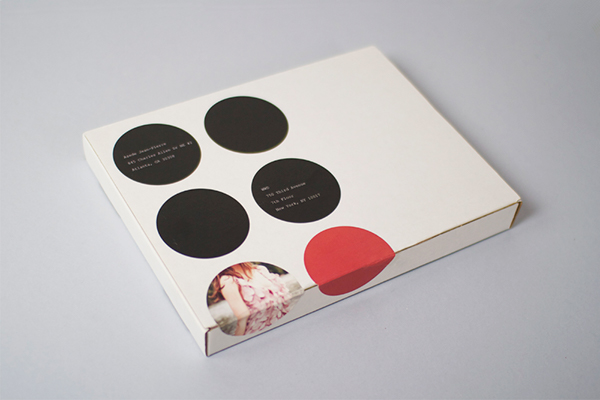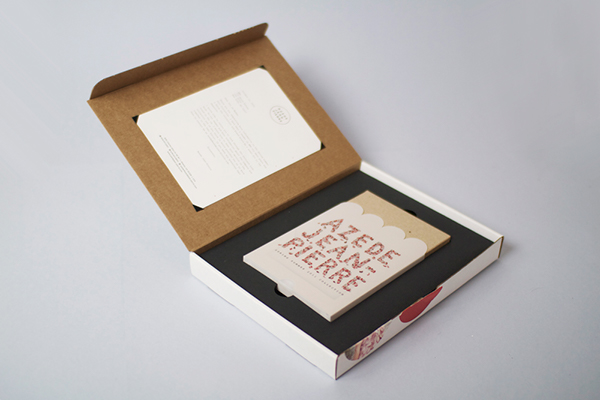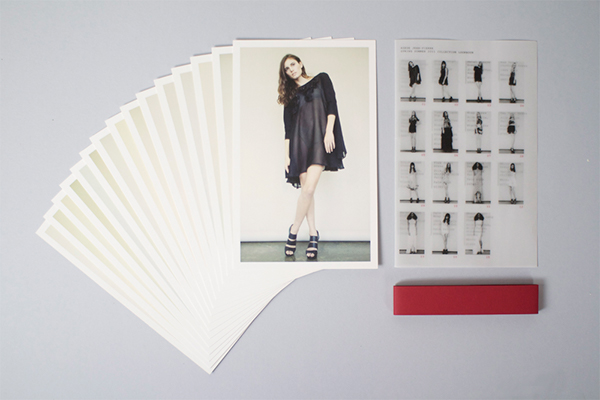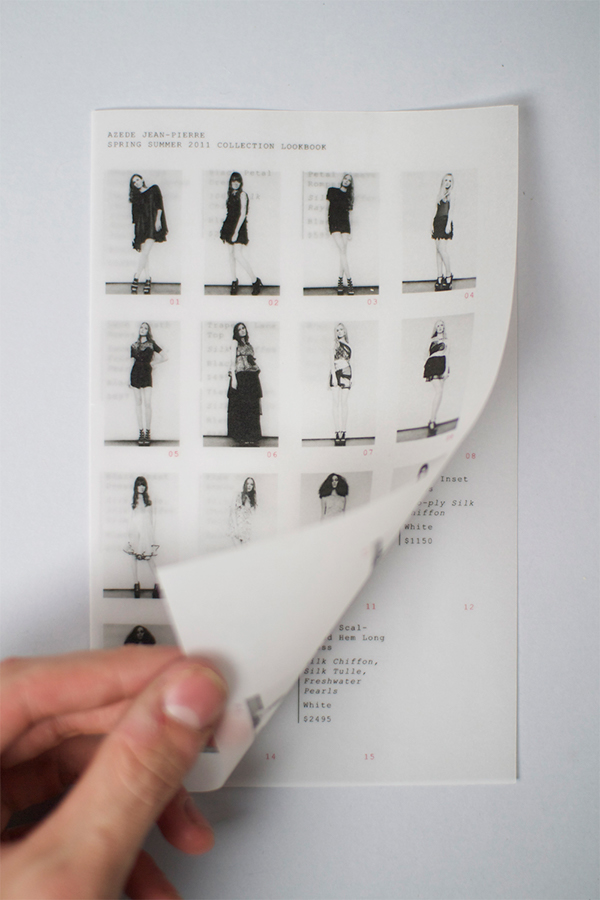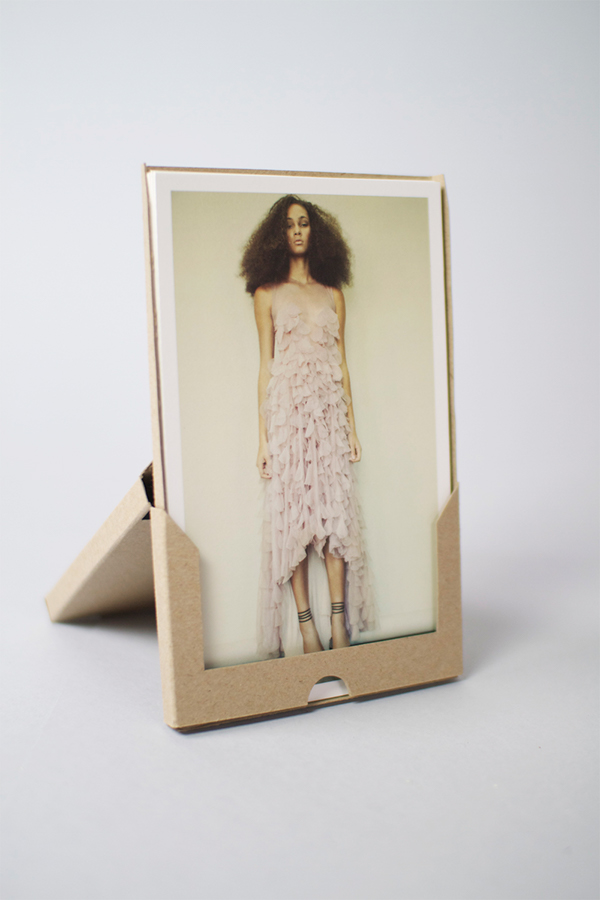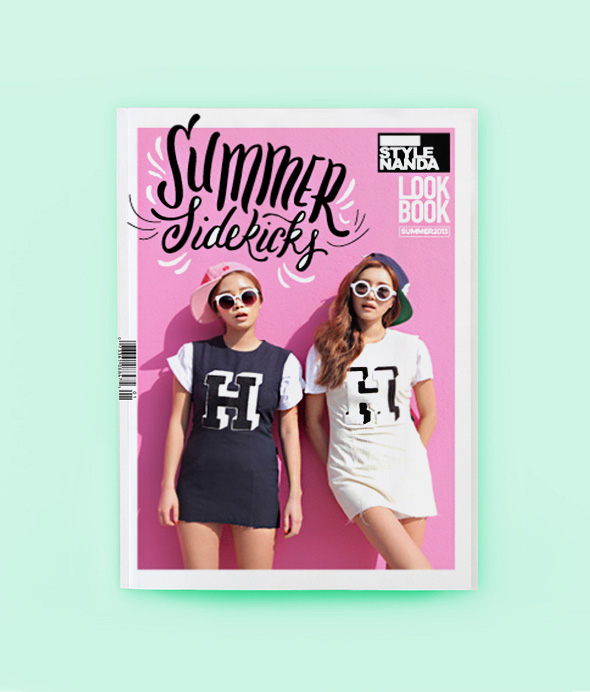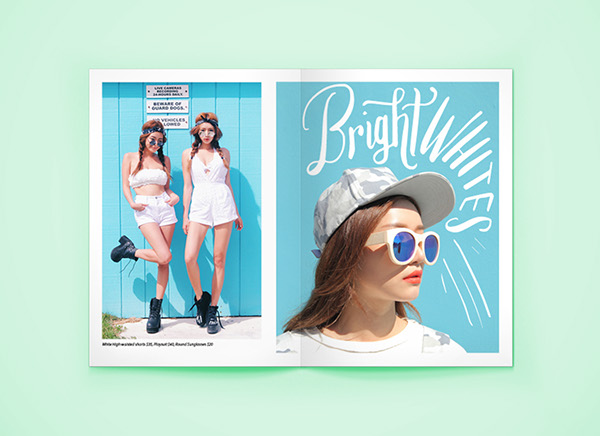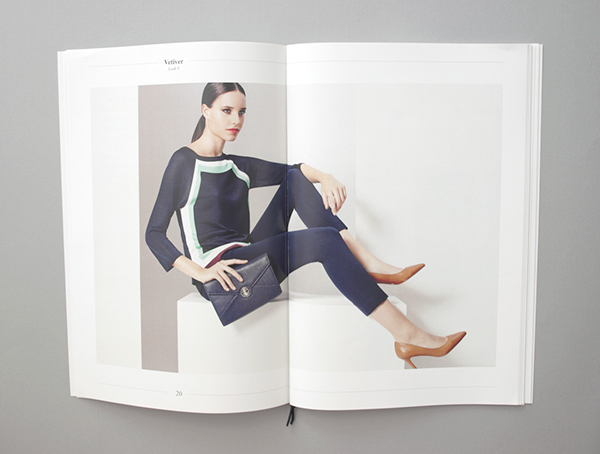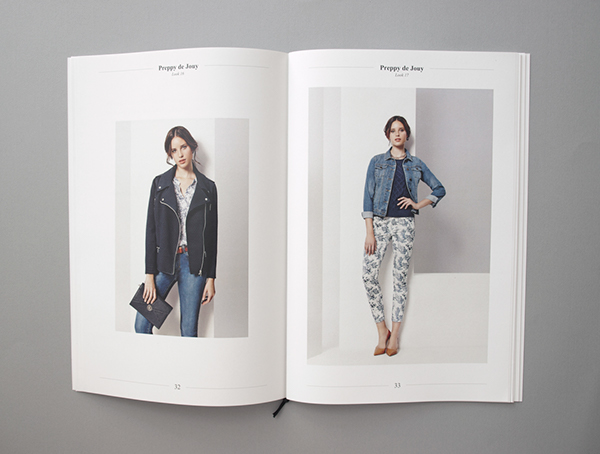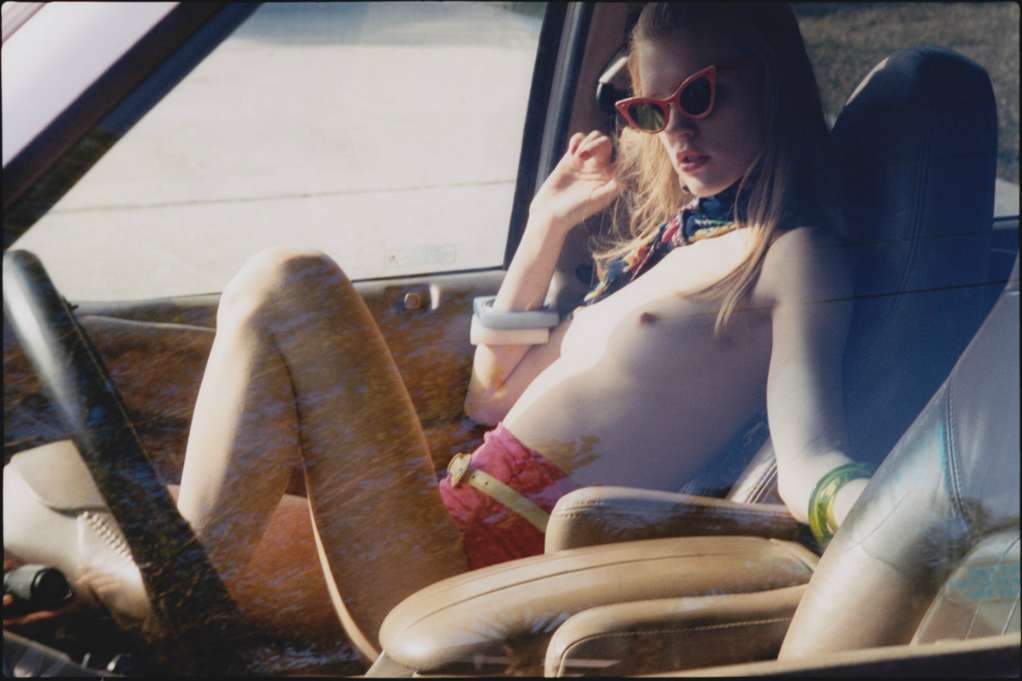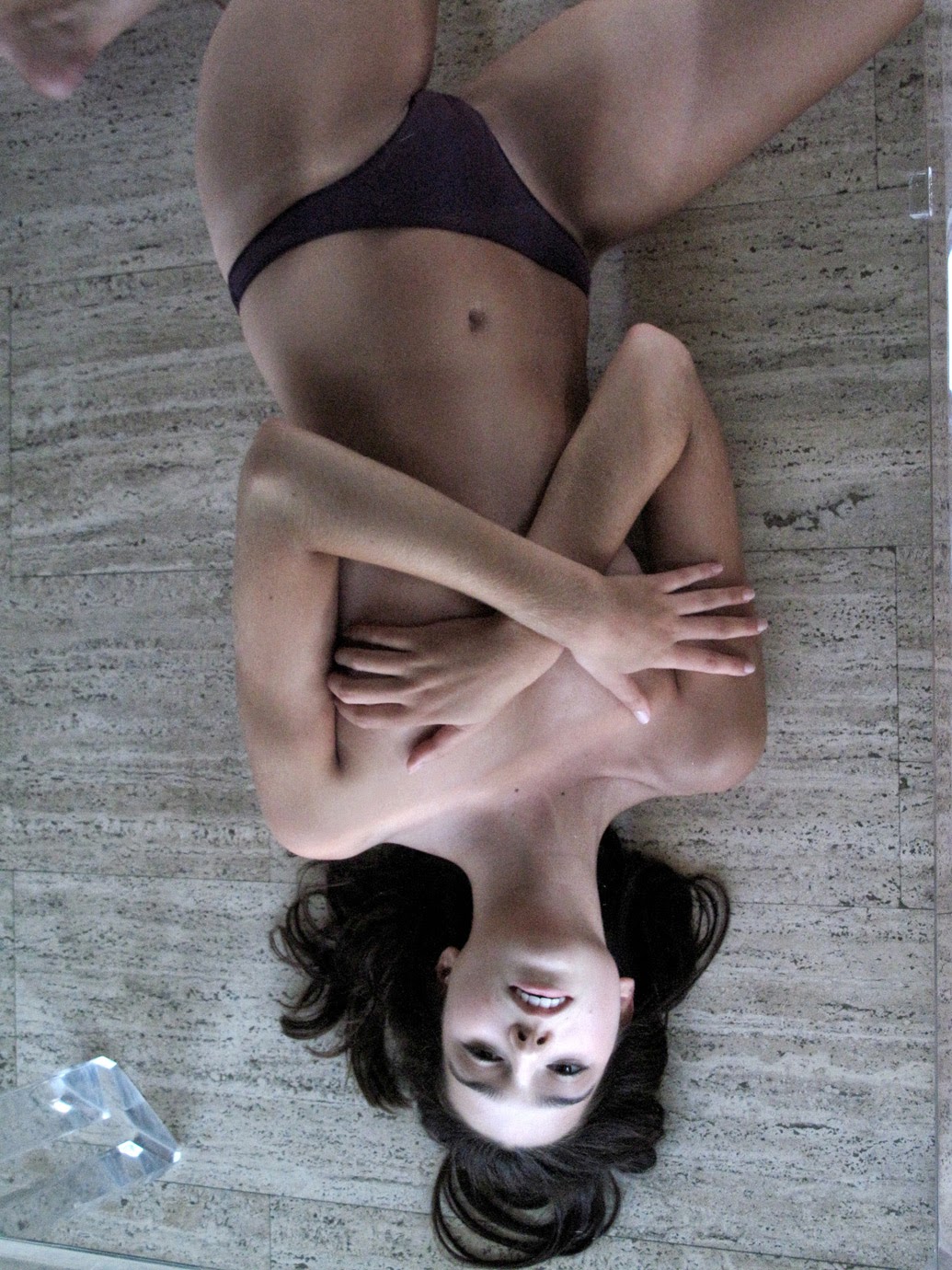Khokhloma or Khokhloma painting (Хохлома or Хохломская роспись in Russian, or Khokhlomskaya rospis', Russian pronunciation: [xəxlɐˈma]) is the name of a Russian wood painting handicraft style and national ornament, known for its vivid flower patterns, red and gold colors over a black background, and the effect it has when applied to wooden tableware or furniture, making it look heavier and metal-like.
- Leave your comment • Category: brief 2 (505), OUGD505
- Share on Twitter, Facebook, Delicious, Digg, Reddit
Terrence "Terry" Richardson (born August 14, 1965) is an American fashion and portrait photographer who has shot advertising campaigns for Marc Jacobs, Aldo, Supreme, Sisley, Tom Ford, and Yves Saint Laurent among others. He has also done work for magazines such as Rolling Stone, GQ, Vogue, Vanity Fair, Harper's Bazaar, i-D, and Vice.
Richardson was born in New York City, the son of Norma (Kessler), an actress, and Bob Richardson, a fashion photographer who struggled with schizophrenia and drug abuse. Richardson was raised in Hollywood, a neighborhood ofLos Angeles, California, where he attended Hollywood High School; and Ojai, California, where he attended Nordhoff High School. He was shy as a teenager and at some times deemed "completely lacking in social skills." He played bass guitar in the punk rock band The Invisible Government for six years. Richardson began photography in high school.
Career
Richardson has shot campaigns for Marc Jacobs, Aldo, Supreme, Tom Ford, and Yves Saint Laurent among others. He has done work for magazines such as Rolling Stone, GQ, Vogue, Vanity Fair, Harper's Bazaar, i-D, and Vice.
Richardson has produced several campaigns for Diesel, including the 'Global Warming Ready' which won a Silver Lion for Print at Cannes Lions International Advertising Festival in 2007. Throughout the years he has also produced several private portraits for the company's founder, Renzo Rosso. In September 2011, they hosted a mutual book launch together with fashion editor Carine Roitfeld, at Colette in Paris.
In 2012 Richardson embarked on his first solo exhibition at Los Angeles's OHWOW Gallery. The exhibition was titled "TERRYWOOD" and ran from February 24 to March 31, 2012. In December of that year, Lady Gaga announced that Richardson was filming a documentary about her life.
Music Videos
Richardson has directed music videos since the late 1990s. He directed videos for Death in Vegas and Primal Scream as well as alternate music video of the song "Find a New Way" by the band Young Love and Whirlwind Heat's "Purple" featuring models Susan Eldridge and Kemp Muhl. He directed the music video for "Red Lips" by Sky Ferreira. He also makes a cameo appearance in Thirty Seconds to Mars' video for "Hurricane". On August 29, 2013 he directed Beyoncé in a music video at Coney Island for her single "XO". Richardson also directed the music videos for "Wrecking Ball" by Miley Cyrus and "Do What U Want" by Lady Gaga andR. Kelly. He also directed Taylor Swift's "The Last Time".
Style
There are several repeating themes in Richardson's work, notably that of putting high-profile celebrities in mundane situations and photographing them using traditionally pedestrian methods, such as the use of an instant camera. His work also explores ideas of sexuality, with many of the pieces featured in his books Kibosh andTerryworld depicting full-frontal nudity and both simulated and actual sexual acts. Initially, many of Richardson's subjects would be shot before a white background but he eventually expanded to other backdrops. He is also well known for posing with his subjects, often trading his trademark glasses with them so they may "pretend to be him" and vice versa.
Controversy
Richardson has been accused of inappropriate sexual behaviour multiple times.
In March 2010 Richardson was accused by Danish model and filmmaker Rie Rasmussen, who was upset at Richardson's use of her picture in his Terryworld book alongside shots of half-naked young girls depicted as performing sex acts. Model Jamie Peck related, "Of all the fine folks I've frolicked au naturel for, he's the only one who's left me feeling like I needed to take two showers." Charlotte Waters took to Reddit to post a similar story of alleged sexual abuse. Waters states, "I wanted to say, 'Hey, I've experienced this first hand. These aren't just rumors.'"
In response to these allegations, Richardson said, "I just want to take a moment to say I’m really hurt by the recent and false allegations of insensitivity and misconduct. I feel fortunate to work with so many extraordinary people each and every day. I’ve always been considerate and respectful of the people I photograph and I view what I do as a real collaboration between myself and the people in front of the camera." In an open letter written for The Huffington Post Richardson added "Sadly, in the on-going quest for controversy-generated page views, sloppy journalism fueled by sensationalized, malicious, and manipulative recountings of this work has given rise to angry Internet crusades. Well-intentioned or not, they are based on lies. Believing such rumors at face value does a disservice not only to the spirit of artistic endeavor, but most importantly, to the real victims of exploitation and abuse."
Vice co-founder Gavin McInnes defended Richardson in 2004, saying “Terry was in deep shit with all of those first-year feminist types about eight months ago over at Deitch," referring to a gallery owned by Jeffrey Deitch who also stood his ground on Richardson's work being displayed.
Model Noot Seear has defended him, claiming that he does not pressure those he works with into doing anything they are uncomfortable with, while designer Marc Jacobs, although admitting problems within the industry, has said that as a person Richardson is "not ill-spirited." Model Charlotte Free defended Richardson on herTumblr account, which was later deleted.
In April 2014, model Emma J. Appleton tweeted an alleged screenshot of a text from Richardson, telling Appleton he would photograph her in Vogue if she slept with him. Appleton later deleted the picture. Richardson's team denied the claim. Political and crisis social media expert Theo Yedinsky stated that the screen capture was indeed a hoax.
Further Allegations
"I don't like to exploit anybody. That's not my bag. Everyone has fun on my shoots," says fashion photographer Terry Richardson. But those who work with him continue to accuse him of sexual harassment, and they've told us their stories.
Last week, the Danish supermodel Rie Rasmussen confronted Richardson in Paris, and said he abuses his position of power within the industry to sexually harass young women with impunity. "They are too afraid to say no because their agency booked them on the job and are too young to stand up for themselves," said Rasmussen. "I told him, 'What you do is completely degrading to women. I hope you know you only fuck girls because you have a camera, lots of fashion contacts and get your pictures in Vogue.'"
Rather than defend himself, Richardson allegedly fled the scene, and instead called Rasmussen's agency to complain about her.
Two days ago, a sometime model named Jamie Peck wrote of an experience she had on a shoot with Richardson six years ago. When she said she wanted to keep her underwear on because she was menstruating, Peck says Richardson asked her to take out her tampon so he could play with it, and make "tampon tea." He insisted on being called "Uncle Terry," and during their shoot, Richardson unexpectedly stripped naked.
"Before I could say 'whoa, whoa, whoa!' dude was wearing only his tattoos and waggling the biggest dick I'd ever seen dangerously close to my unclothed person (granted, I hadn't seen very many yet)." In Peck's words, Richardson eventually "maneuvered" her over to a couch in his studio, where he "strongly suggested I touch his terrifying penis." When he ejaculated, one of his assistants gave Peck a towel.
Richardson also reportedly left his then-wife, former model Nikki Uberti, for Shalom Harlow when Uberti was diagnosed with breast cancer at age 29.
Following the publication of Peck's allegations, other stories of Richardson's questionable behavior at work poured forth. I heard from modeling agency bookers and former bookers, photographers (many of whom told me that they are disgusted by Richardson in part because by propagating the idea of the fashion photographer/predator, he makes their jobs harder), fashion writers, magazine editors, models of all descriptions, stylists, and others in the industry. Because of Terry Richardson's extraordinary position of power, all of these people spoke to me anonymously, for fear of losing their own jobs or being blacklisted in an industry that hates to endure any overt challenge to its power structure.
One fashion insider says agencies "know full well Richardson's predatory behavior," but that he "is tolerated because the industry folk are just sheep. There are only a handful of photographers who have the power, a handful of editors who have the power, and a handful of clients who have the power. Everyone else just follows this small group of people." In a multi-billion-dollar industry where the product is subject to a high level of uncertainty — will this be the look of the season or will that? Will this trend take off or will that one? — people tend to cluster around the handful of people who are powerful enough to actually influence outcomes. Because Richardson carries the dual stamp of editorial approval of Anna Wintour and her French counterpart Carine Roitfeld, and because he also shoots for behemoth commercial clients like H&M, his entrenchment in the fashion pantheon is virtually complete. And that, says the source, makes him practically untouchable. "Those people in power, the women, need to take their responsibility for what happens to the girls because by booking him, they are tacitly giving their approval that whatever he does is OK."
Several people pointed out that while Richardson shoots frequently for major titles including American Vogue, Harper's Bazaar, Vogue Paris, British Vogue, i-D, V, and GQ, he has one curious, and high-profile, exception to his editorial credits: W magazine, where Richardson's services are apparently not in demand. Two current and former W staffers confirmed that Richardson has not worked with the magazine in a while; another individual thought the most recent instance of his work appearing in the magazine dated to a Mexico City-shot story, with model Esther de Jong, in the mid-1990s November, 1996 issue.
We've asked W's art director, Dennis Freedman, why this is so; one source heard a rumor at the time that the ban on Richardson's work was instituted because Freedman took offense at a Richardson photo of a model posed with her head in an oven. Freedman has yet to comment —there's some other stuff going on at W this week — but we'll update if and when he does.
A story from 1999, indexed here, about a payment dispute Richardson had with the French label Paul & Joe, mentions that at the time, Kate Betts "seems to have put an end to [Richardson's] short-lived stint at Harper's Bazaar." Betts, who now writes for Time, was editor-in-chief ofHarper's Bazaar from June, 1999, until June, 2001, and it was only under the reign of her successor, Glenda Bailey, that Richardson's work returned to the fore. (Richardson shot three covers for the magazine, counting subscriber covers, in 2009 alone.) Betts claimed not to recall why she didn't use Richardson during her tenure at Harper's Bazaar when I asked her about it yesterday afternoon. But there are clearly people in fashion on whom Richardson's particular charms are lost, and people who do not seek to deny, tolerate, or excuse what he does.
Meanwhile, these stories of Richardson's behavior speak for themselves:
I was a model in the late 90s in London, and I was booked on a Terry Richardson job for Arena Homme Plus. The shoot was at an amusement park, and I would estimate that there were 30 models in total [...] and we were told that all of us would be given an opportunity to shoot a cover try. Being familiar with Mr. Richardson's.....peccadillos, many of the models were eager to please; pleasing in this instance consisted primarily of pulling down pants, pulling up skirts, losing blouses, and a bit of finger sucking thrown in for good measure. It seemed painfully clear to me that the phantom lure of a cover try was sufficient reason for a handful of young women with waning career prospects to humiliate themselves in front of each other while Terry Richardson giggled, panted, said "That's hot," and pushed them further. During lunch, I approached him and asked him if he had any moral quandaries about exploiting the sad dreams of models who hadn't yet made it and probably never would. I asked him if he realized that they were enacting what they believed were his expectations and fantasies in order to gain his favor and hence gain a cover or a future booking. "I don't really think about that stuff," he told me. "I guess you're smarter than me."
Indeed.
We also heard from a woman who is friends with a stylist who used to work with Richardson. "She quit because of having to watch him sexually harrassing/abusing two (naked) teenage Eastern European models who didn't speak English — she didn't speak up and was so ashamed I don't think she did anymore styling for quite a while afterwards."
One woman in the industry said, "People should also be asking Terry why he doesn't shoot black girls." It's true that Richardson's extensive fashion work features almost exclusively white models. In fact, I struggled to find this single example of Richardson using a black model for a fashion story.
The following story comes from the only source who wrote to me from an anonymous e-mail address, and who has not responded to my follow-up questions. Does this cast doubt on her allegations? It's for you to decide. I present her story here because even if it cannot be verified, it is still, I believe, worth hearing. The writer says she was 19 at the time of her Richardson shoot, which was two years ago. She took a gig she understood to be "shooting artful nudes" because she'd lost her coffee shop job and needed the income:
He first asked me to play with myself, and just made really creepy demands.
He said it wasn't pornish because he was shooting still shots, and when I said that I felt like he was seeing if I was just dumb, he handed me the camera and said, "Fine you should [shoot] me playing with myself."
I mean his assistants were like, "Do you think all these celebrities would take pictures with him if it was porn?"
Then he said to take pictures of him touching me.
Eventually, he had me go down on him and took pictures of him coming on my face, which I had never done before, and when I went to the bathroom to clean up I could hear him and an assistant joking about it which is when I decided to never tell anyone.
The writer says she later called Richardson and asked for the pictures not to be used. "He said I had already been paid and that I had signed the release. I just didn't want anyone to know about what I'd done and what an idiot I was to let myself be used like that."
Sarah Hilker, who is now a freelance fine art model based in Los Angeles, was 17, and had just quit high school in order to break into modeling in New York City when she met Terry Richardson. Armed with "a perfect fake" ID, Hilker went to a party for the hipster pin-up website Suicide Girls, which was at the time planning the launch of a magazine. The party was in early 2004, and Richardson was the event photographer — in fact, it was the same event where Jamie Peck initially encountered Richardson. Hilker writes that she went to the bar where the party was being held with a friend:
My "friend" looked at me and actually said, "It's not who you know, it's who you blow!" His friend walked me over to this nearly invisible door to the backstage where the real party was going on. I slowly opened it and walked in. The entire room STOPPED and stared at me. That immediately made me uncomfortable. In one corner there was a literal pile of SG bras and panties and the other was a small table with model release forms. Some stranger immediately grabbed me and whisked me over to the panties pile meanwhile, another person came over to me and shoved a model release form in my face. They had no interest in seeing my I.D. or even asking me any questions. I was being pushed towards the front of the line to go shoot with their panties and a blank model release form in my hands. I hadn't even had time time get undressed to put them on.
I saw him shooting some obviously inebriated chick straddling a full naked erect guy with her SG panties pulled over to the side one hand on the camera; the other hand grabbing his cock over his pants. I'm like HOLY SHIT! I immediately backed away, ran through a bunch of drunk women, confused business people, and out the door like I had just had the worst nightmare imaginable.
[...]To this day, I think it was one of the best decisions I've ever made.
The point of this investigation into Richardson's behavior — which, I hope, is only just beginning — isn't to lead some kind of crusade against the photographer, but to give a voice to the many, many people who, whatever their opinions of his work or his talent, object to the way he treats many of the women he works with — as potential receptacles for his dick. In a witch-hunt, the witch is the blameless one: but Richardson, like any predator, is a powerful individual who manipulates and victimizes the weak. When they speak out against him, people try to silence them. The power structure protects its own. But why should sexual harassment be tolerated? How is it "daring" or evidence of one's heightened sensitivity to the "creative" life to speak up for a wealthy member of the establishment with a client list longer than the hairs of his pedo-stache? Why is Richardson the untouchable one?
And, most importantly: Why do publications like American Vogue and companies like Prada, Gucci, and H&M think that a man who sees nothing wrong with interrupting the workday to manipulate his young models into performing sex acts on him, while his assistants look on, is worthy of continued patronage? What about that behavior is praiseworthy, Anna Wintour?
http://www.vocativ.com/underworld/sex/oh-god-whats-happening-close-personal-terry-richardson-model/
Information About American Apparel From Online:
American Apparel is a Los Angeles, California based clothing manufacturer, distributor, and retailer in the United States. It is a vertically integrated clothing manufacturer, wholesaler, and retailer that also performs its own design, advertising, and marketing. It is best known for making basic, solid-color cotton knitwear such as T-shirts and underwear, but in recent years it has expanded—to include leggings, leotards, tank tops, vintage clothing, dresses, pants, denim, nail polish, bedding and accessories for men, women, children, babies, and dogs in various prints and colors.
American Apparel was founded in 1989 by Canadian Dov Charney, who had a long history with T-shirts and a fascination with American culture.[citation needed] It was during Charney's freshman year at Tufts University that the company took on the name "American Apparel" and began to experiment with screenprinting, importation and other parts of the apparel business. In 1997 after a variety of iterations, including a period of manufacturing in South Carolina, the company moved to Los Angeles. Charney began to sub-contract sewing with Sam Lim who, at the time, had a shop with 50 workers under the Interstate 10 freeway in east LA. Months later the two became partners. In 2000 American Apparel moved into its current factory in downtown Los Angeles where it continued to grow primarily as a wholesale business, selling blank T-shirts to screenprinters, uniform companies and fashion brands. After its experience as a wholesale brand, the company moved into the retail market. The company was ranked 308th in Inc.'s 2005 list of the 500 fastest growing companies in the United States, with a 440% three-year growth and revenues in 2005 of over US$211 million.
In late 2006 American Apparel went through a reverse merger and is now listed on the American Stock Exchange.
It is also one of the few clothing companies exporting "Made in the USA" goods and in 2007 sold about 125 million dollars of domestically manufactured clothing outside of America. The company promotes labor policies that exclude use of clothing manufactured in sweatshops."
In 2010, American Apparel's auditors, Deloitte & Touche, resigned after informing the company that its financial statements for 2009 may not be reliable. The resignation led to investigation by U.S. Securities and Exchange Commission and the United States attorney’s office for the Southern District of New York.
In April 2011, American Apparel confirmed that it had secured $14.9 million in financing from a group of Canadian investors. Under the deal announced, American Apparel sold some 15.8 million shares of common stock at 90 cents a share to a group of investors led by Michael Serruya and Delavaco Capital. The investors also received warrants to buy as much as 27.4 million additional shares.
In April 2013, American Apparel issued a private offering of $206 million in senior secured notes. This sale eliminated the companies long-standing, high-interest debt with Lion Capital and Crystal Financial.
Production
American Apparel bases its manufacturing in a seven-story 800,000-square-foot (74,000 m2) factory in downtown Los Angeles, California where it produces more than 55,000 different products and garments.
The company also owns and operates its own fabric dye house, garment dye house, and knitting facility, all based in Los Angeles. American Apparel has decided not to outsource its labor, paying factory workers an average of over twelve dollars an hour and often more than $100 a day. Garment workers for similar American companies in China earn approximately 40 cents per hour. It claims to have the 'highest earning apparel workers in the world'. The factory claims to have the capacity to produce 1 million shirts per week and manufacture 275,000 pieces a day. According to The New York Times it is the largest single garment factory in the United States and employs more than 4,000 people across two buildings.
A banner on top of the downtown factory states "American Apparel is an Industrial Revolution." As of December 2008, banners on top of the factories state "Legalize LA" and "Immigration Reform Now!".
Vertical integration
American Apparel is a vertically integrated company. The integration extends to 260+ retail storefronts, all of which are owned by the company. By integrating all aspects of production and avoiding outsourcing, the company achieves a fast turn-around time from design concept to finished product. Because of its vertically integrated and domestic manufacturing model, American Apparel's gross margins are actually significantly higher than other basic apparel brands. According to the company, its blended margins are roughly 70% (while GAP averages about 30% and luxury brands like Prada are between 65% and 70%).
Retail
The company's expansion into retail was the fastest retail roll out in American history. In 2003 American Apparel opened company stores in Los Angeles, Montreal, and New York to nearly $80 million in sales. As of 2008 the company has more than 200 stores worldwide and continues retail growth with new stores in the United States, Israel, Italy, Australia, Japan, South Korea, the Netherlands, Switzerland, China, Germany, Austria, Canada, France, Sweden, Spain, Mexico, United Kingdom,Ireland and Brazil. Stores are planned or under development for Belgium, Iceland, China, and Hawaii.
AmericanApparel.net is the company's e-commerce sales hub. It carries an online inventory of roughly 250,000 SKUs and receives 1.5 million visitors per month. Online sales grew from $13.3 million in 2006 to $29.3 million in 2007 to roughly $40 million in 2009 to $43.1 million in 2011. The company site runs on the Yahoo Stores platform and is included in the Internet Retailer 500 Index.
In 2008, the company was named "Retailer of the Year" at the 15th Annual Michael Awards for the Fashion Industry, following Calvin Klein and Oscar de la Renta.
Wholesale[edit]
American Apparel began by selling high-quality t-shirts to screen-printers and boutiques in 1990 under the American HEAVY label. Although it has made its transition into a primarily retail brand, the company is still one of the largest wholesalers in the country. American Apparel shirts are used as band merchandise and concert t-shirts for the bands, among many others, Hanson, Van Halen, Wilco, Death Cab for Cutie, Foursquare, Vampire Weekend, Metric, and Flogging Molly as well as websites likeThreadless, Busted Tees. People for the Ethical Treatment of Animals, the animal rights advocacy group, prints its merchandise on American Apparel clothes because they are made domestically and animal-free.
Branding and advertising
American Apparel designs, creates and prints its own advertisements. The company is known for its provocative and controversial advertising campaigns, which is largely the inspiration of the company CEO Dov Charney. According to Adage, American Apparel's advertising 'telegraphs the brand' from person to person. Their print campaigns are widely considered to be some of the best in the industry. The sexually charged advertising has been criticized, but has also been lauded for honesty and lack of airbrushing.
According to CEO Dov Charney, the vision for the brand is that of a “heritage brand. It's like liberty, property, pursuit of happiness for every man worldwide. That's my America." In regards to the company's image overseas, advisor Harry Parnass stated that the brand is about aspiration and that they are "selling the American dream."
American Apparel images often display subjects with their blemishes, imperfections and asymmetrical features highlighted and attached with brief, personal descriptions. Many of the models in American Apparel's advertising are recruited by Charney and his colleagues on the street, or company stores; others are selected after sending their photos directly to the company website.
The company has also used pornographic actors in some of its ads including Lauren Phoenix, Charlotte Stokely, Sasha Grey and Faye Reagan. Some of the company's other ads, which feature nudity or sexual themes, have been banned by various advertising authorities. In 2009, an American Apparel ad which appeared in VICE Magazine was banned in the UK, because the image "could be seen to sexualise a model who appears to be a child". While the model was 23 at the time, it was said the ad had the potential to "widely offend" people. In one image the woman's nipple was partially exposed. American Apparel complied with this ruling. American Apparel also came under fire for a 2014 ad for mini-skirts, which featured a model bending over so that her underwear was prominently exposed. In 2013, the company released an ad in which the model lay on a bed with her feet up in the air without wearing pants. The company also released an ad in which a model posed in a series of photos focused on her crotch, in which her face was not seen. The UK Advertising Standards Authority criticized the ad for being "voyeuristic," and "vulnerable."
For a time, Charney used a branding strategy that spotlighted his treatment of workers, promoting American Apparel's goods as "sweatshop free." In 2014, the company released a controversial ad with a topless model, and the words "Made in Bangledesh," across her chest,in an effort to draw attention to the company's fair labor practices. In 2008, the company took out a series of political ads featuring the corporate logo that called current immigration laws an "apartheid system."
In 2005 the company was named "Marketer of the Year" at the first-ever LA Fashion Awards. Women's Wear Daily published a survey in April 2007 from Outlaw Consulting, a creative research firm tracking the habits of 21- to 27-year-olds, which ranked American Apparel as the 8th most trusted brand, ahead of such clothing brands as H&M and Levi's.
In 2007, Imp Kerr created a fake American Apparel ad campaign in New York. The stunt lasted almost a year, until it was revealed that the fake ads were actuallyPhotoshop mockups. American Apparel ran a tribute ad on the back cover of Vice magazine showing a compilation of the fake ads.
In January 2008 the Intelligence Group, a trend and market research firm, listed American Apparel as their number two Top Trendsetting Brand, behind only Nike. In 2008, The Guardian named American Apparel "Label of the Year".
Woody Allen billboard and lawsuit
In 2007, American Apparel put up two billboards, one in New York and one in Los Angeles, featuring an image of Woody Allen's character dressed as a Rabbi from the movie Annie Hall and Yiddish text, for a period of one week. According to Charney, the billboards were a satire and allegory alluding to both the scene in the movie and the similar controversy experienced by both individuals. Allen strongly objected to this use of his image and sued the company for $10 million. Allen testified at a December 2008 deposition that he considered the company's advertising to be "sleazy" and "infantile."
Although the company said as early as May 2008 that the billboards were meant "strictly as social parody", there was much debate over whether American Apparel's lawyers would unfairly use Allen's personal life, namely his affair with Soon-Yi Previn as their defense at the trial. Charney claimed that these rumors were outright false and that his speech was protected by the First Amendment. In May 2009, the case was settled by American Apparel's insurance carrier for $5 million, with the insurance company paying the bulk of the settlement. The settlement was for half of Allen's initial demand. Dov Charney said that if it had been up to him, he would have continued the case and taken it to trial.
In addition to participating in a variety of immigration protests, the company launched an advertising and advocacy campaign called "Legalize LA". The campaign featured advertisements in national papers like The New York Times as well as billboards, t-shirts, bus ads and posters. The company also maintains a Legalize LA portion of their website that features news articles relating toimmigration reform, the brand and information on the history of the issue.
After the passing of Prop 8 (which defines marriage in the state as one man and one woman) in California in November 2008, American Apparel launched the Legalize Gay campaign. It is similar to the Legalize LA campaign, and shirts with "Legalize Gay" and "Repeal Prop 8" printed on them in the same style as the shirts of Legalize LA are sold by the company.
In June 2012 American Apparel partnered with the Gay and Lesbian Alliance Against Defamation in releasing a new line of t-shirts to celebrate LGBT Pride Month. Fifteen percent of the net sales of the shirts were donated to GLAAD. Isis King modeled for this line, becoming American Apparel's first openly transgender model. In the summer of 2013, American Apparel announced their desire for more "transexy" models.
In 2013, American Apparel was named one of TheStreet.com's "8 Pro-Gay Companies."
The production system of American Apparel centralizes most of its employees in a single location. By not outsourcing, Charney believes that he knows his workers better and that it ties them directly to the brand. A banner on top of the downtown factory states "American Apparel is an Industrial Revolution."
Charney has stated that American Apparel hires its creatives by their sense of culture and fashion, not their resume. Conversely, the company has also been accused of focusing on personal style and outward appearance in its hiring practices for retail positions. According to Charney, the unconventional corporate culture at American Apparel is responsible for the company's creativity and rapid growth. He's stated that the company is open about sexuality and its culture because "young people like honesty."
American Apparel has been subject to seven public sexual harassment lawsuits, though to date, they have all been dismissed, "thrown out," remanded to arbitration, or in one case, settled but with "no monetary liability to the company." As of 2013, American Apparel has not paid any money in settlement of or as punishment for any of the claims. In one prominent case, the company was sued by four ex-models for sexual harassment—including one separately named plaintiff who sued the company for $250 million—in a lawsuit which involved mutual nude photographs, sexual text messages and requests for money. The company was accused of being responsible for these leaks in a later lawsuit. However, the case was dismissed by a New York City judge in 2012. In another case, American Apparel was reprimanded in an opinion by the Second Appellate District for a settlement in which plaintiff confessed that she had not been subjected to sexual harassment and American Apparel attempted to issue press release which mentioned an arbitration hearing that had, in fact, never taken place. As of 2013, only one case, a "class action [lawsuit] on behalf of all female employees" which contains no "specific allegations against Charney," remains active. In response to the lawsuits, American Apparel has claimed that the lawsuits were extortionary attempts to "shake the company down," and has run advertisements saying so. Charney has maintained his innocence in all the lawsuits, telling CNBC that “allegations that I acted improperly at any time are completely a fiction."
As of 2008 the company employs more than 10,000 people and operates more than 200 retail locations in 20 countries. The company pays its manufacturing employees an average of $12 per hour. According to the San Francisco Chronicle the average factory worker at the company makes $80–120 per day, or roughly $500 per week compared to the $30–40 made daily at most other Los Angeles-based garment factories. Employees also receive benefits such as paid time off,health care, company-subsidized lunches, bus passes, free English as an additional language classes, on-site massage therapists, free bicycles and on-site bike mechanics, free parking in addition to the proper lighting and ventilation. Every floor of the factory includes free telephones where workers can make and receive long distance phone calls. The company's employees in foreign countries do not receive the same hourly wages as their Los Angeles counterparts. However, employees in China will earn US Federal minimum wage. After going public, the company offered employees as much as $40 million in stock shares. The plan grants employees roughly 1 share of stock for every workday they'd spent at the company. Approximately 4,000 of the company's employees are eligible for the program. In previous years the waiting list for employment at American Apparel has had over 2,000 names on it. The company now however is actively looking for staff following an investigation by US immigration found that 1,500 of its workers lacked the legal immigration documents and were subsequently dismissed.
New York Times reporter Rob Walker wrote about the controversy in his book Buying In and revealed that since the unionization drive, the company Sweat X, which was held up as the example for what American Apparel should be, had since gone out of business. He quotes Charney saying more explicitly that "[Sweat X] ... fucking failed."
The differences between American Apparel and Sweat X were the subject of the 2010 documentary No Sweat.
As early as 2001, American Apparel has been a vocal advocate for reform of U.S. immigration laws. On May 1, 2002 American Apparel shut down its factory to allow the company's workers, many of whom are immigrants, to participate in a pro-immigration rally in downtown Los Angeles. Dov Charney, a Canadian, also marched alongside the workers. American Apparel participates annually in the May 1st Immigration March and Rally in downtown Los Angeles. In 2008, they added a route from their factory that eventually connected with other supporters near the city hall. The company's politics were eventually spun off into the Legalize LA advertising campaign.
In 2009, an ICE audit of American Apparel's employment records uncovered discrepancies in the documentation of about 25% of the company's workers, implying mainly that they were undocumented immigrants. About 1,500 workers were let go in September of that year as a result. American Apparel responded with questions of the effectiveness of such an action and said "[the firings] will not help the economy, will not make us safer. No matter how we choose to define or label them [undocumented immigrants] are hard-working, taxpaying workers.” The ICE audit highlighted a new strategy from President Obama which announced they were shifting away from high profile raids. According to CEO Dov Charney, American Apparel promised its workers who were fired for improper immigration documentation that they would be given "priority treatment, in terms of being interviewed for future positions with the company," if and when they when they "got [their] immigration papers in order." [120]Commenting on the loss of 1,500 workers due to concerns over illegal immigration Charney said "It broke our efficiencies and generated a situation where we were late delivering garments. It lost us an enormous amount of money. It cost us agility."
Environmental policies[edit]
The company depends on environmentally friendly practices and is known for its innovations in sustainability due to vertical integration. American Apparel manufacturing system is designed around the concept of "Creative Reuse"—which converts excess fabric from one garment template into several additional garments such as bathing suit tops, belts, headbands, bows, bras, underwear and children's clothing. This otherwise wasted material reduces the amount of fabric the company needs to produce in addition to expanding its product line and saves approximately 30,000 pounds of cotton per week.
American Apparel maintains a bicycle lending program for its employees and according to People for the Ethical Treatment of Animals it is a vegan-friendly clothing company. As of 2007 the company planned to increase its use of organic cotton within the next four years from over 20% to 80%. American Apparel also sells a line of shirts under the "Sustainable" label that are 100% USDA organic cotton. In 2008, American Apparel purchased over 30,000 pounds of organic cotton known as B.A.S.I.C cotton.
American Apparel installed a 146 kilowatt solar electric system on its factory roof, designed to reduce power costs by at least 20%. These panels power as much as 30% of the factory. The company also recycles its fabric scraps.
Philanthropy[edit]
In 2005, the company hosted a bikini car wash benefit with the American Red Cross to raise money for the victims of Hurricane Katrina. In addition, they packaged and delivered 80,000 shirts to the relief effort in New Orleans and the Gulf Coast. As an underwriter of Farm Aid, American Apparel donates the blank shirts that the organization prints and sells as merchandise. In 2007, right before Christmas, American Apparel donated more than 300,000 articles of clothing, with the giveaway specifically targeting the homeless population of large cities. In 2009, the company had a "Justice for Immigrants" factory sale in Los Angeles—the proceeds of which benefitted organizations such as the Casa Libre Immigrant Children's Homeless Youth Shelter, the Center for Human Rights and Constitutional Law, the Coalition for Humane Immigration Reform of Los Angeles, Hermandad Mexicana Latinoamericana, and the National Day Laborers Organizing Network.
American Apparel also donated more than $400,000 worth of garments to the victims of the Haitian earthquake through Fashion Delivers as well as over 5,000 pairs of socks to the shoe charity Soles4Souls.
Dov Charney (born January 31, 1969 in Montreal (Quebec - Canada)) is the founder and CEO of American Apparel, a clothing manufacturer, wholesaler, and retailer which he started at age 20.
As a fashion entrepreneur, he's known for a passion for simple basic clothing and unusual leadership style, which includes being involved in nearly every part of the business process from design, manufacturing, and marketing.
At American Apparel, Charney pioneered the Made in USA sweatshop-free model of fair wages and a refusal to outsourcemanufacturing. Charney has also been associated with several controversial lawsuits, including a $10M lawsuit fromfilm director Woody Allen and sexual harassment lawsuits involving ex-employees.
The Los Angeles Times named him as one of the Top 100 powerful people in Southern California and in 2009, he was nominated as a Time 100 finalist by Time magazine.
Charney has been the subject of several sexual harassment lawsuits, at least five since the mid-2000s, that are either still pending or have settled or been dismissed. Through early 2010, none of the accusations had been proven. Some cases remain pending, but the remaining were dismissed, remanded to private arbitration, or “thrown out”.
Charney maintained his innocence in all the lawsuits, telling CNBC that “allegations that I acted improperly at any time are completely a fiction." The company and independent media outlets have publicly accused lawyers in the lawsuits against American Apparel of extortion and of "shaking the company down." On the eve of trial in one case, the plaintiff confessed that she had not been subjected to sexual harassment and agreed to go to an arbitration hearing aimed at clearing Charney's name. However, the plaintiff failed to show up to the hearing and a ruling was unable to be reached. As a result, the $1.3 million settlement was dissolved and the matter reemerged as a negative media controversy for Charney. The company was later sued by four ex-models for sexual harassment, including one separately named plaintiff who sued the company for $250 million. The latter lawsuits were subject to much controversy when unsolicited nude photographs, consensual sexual text messages and requests for money surfaced. Charney was accused of being responsible for these leaks in a later lawsuit.
In 2004, Claudine Ko of Jane magazine published an essay narrating multiple sexual exchanges that occurred between them while spending time with Charney. The article said that Charney consistently propositioned his employees. Charney admitted to using the word "sluts" in front of employees, in a deposition on another sexual harassment case, and denied that "slut" was a derogatory term. The article's publication brought extensive press to the company and Charney, who later responded that he believed that the acts had been done consensually, in private and outside the article's bounds.
American Apparel was sued in 2010 for allegedlyterminating an employee who was undergoing cancer treatment, CBS Los Angeles reports. The company settled the lawsuit for $60,000 in 2011, according to Daily News. Spokesman Peter Schey told HuffPost that American Apparel "agreed to intensify its training about the requirements of the Americans With Disabilities Act" following the the settlement, and now "has a policy that goes above and beyond what the law requires with regards to accommodating people with disabilities."
American Apparel hires workers only after taking a full-body photograph of them and has faced accusations that it only hires the best looking candidates, Gawker reports. Likewise, CEO Dov Charney reportedly personally went through photos of store employees and requested that any"ugly people" be let go, according to one store manager. For its part, American Apparel says itspolicy is to hire workers who are knowledgable about its products.
In 2011, garment worker Tuan Phan was killed by a circular knitting machine at one of American Apparel's factories. Calling the incident a "freak accident," American Apparel spokesman Peter Schey said "the company immediately took steps to avoid this type of terrible accident ever happening again," adding it is "fully committed to worker health and safety."
American Apparel paid out over $300,000 in damages after a worker sued for being called "n****r" by his superior repeatedly, Gawker reports. The company has also been accused of profiling customers, running racist ads and making racially insensitive products. "Under no circumstances does the company think racial slurs are appropriate," Peter Schey told HuffPost.
American Apparel's racy ads have been bannedrepeatedly for showing nudity, supposedly being exploitative and sexualizing child models.
American Apparel has been flirting with bankruptcy since 2010, coming especially close in the spring of 2011 after losing around $86 million. Despite calls for the company to outsource production due to the financial strife, it remained committed to "domestic production, fair wages [and] positive working conditions," according to American Apparel's Peter Schey. An $80 million credit infusion from billionaire George Soros in 2012, however, appears to have put the clothing company on more solid financial footing.
A 2012 lawsuit brought by former employee Michael Bumblis accused CEO Dov Charney of throwing dirt at a store manager and calling him a"fag" and a "wanna be Jew," The Huffington Post reports. "Dov Charney and witnesses deny that Charney ever assaulted or rubbed dirt in Mr. Bumblis's face," spokesman Peter Schey told HuffPost. "Mr. Bumblis sued only after being terminated for cause (after numerous warnings about his conduct before and after the alleged dirt-throwing incident)."
In 2011, America Apparel ran a contest called "The Next Big Thing," which sought a plus-size model for its new larger line of clothing. Nancy Upton's collection of ironic photos for the contest was the popular winner but American Apparel chose not to give her the top prize because of her "attempts to discredit the positive intentions of our challenge," a spokesperson wrote at the time.
American Apparel was forced to fire 1,800 employees after a federal audit unveiled irregularities in the documents immigrant workers provided American Apparel in order to get hired, The New York Times reports. "We interviewed every worker one by one to ensure that we were absolutely certain that we didn't terminate anyone who had a right to be here," American Apparel's Peter Schey told HuffPost.
WARNING. THIS BLOG POST CAN BE QUITE EXPLICIT.
Binding Methods & Folds
French Folding could be used as you could create 'secret' pages inside each fold..
Look Books
I've noticed that Look Books are highly image orientated, with a few quotes or bits of text here and there. I like this way of designing the publication, as I will be able to focus on the imagery and comparison through the images, rather than banging loads of text into the book that people won't necessarily want to read!
It's interesting to see how images can be manipulated to create a story and sense of drama.
Within this look book, I really like the idea of having half sized pages to separate full bleed imagery. The neon colours and small amount of text compliment the black and white photography within the book.
I thought that the look book could possibly be packaged, so that it feels more luxurious than the erotic content inside. I quite like the way these photos have been printed as flash cards, as well as in a book so that you can have a separate collection of the images.
I really love the use of pastel colours within this look book - the photographs and layout of the pages and typography are all really complementary of one another, so it works well as a full edition.
The clarity of this look book works really well, as the simplicity brings full attention to the photos within the book - there are no distractions. The photos are really well taken and the colour schemes are aesthetically pleasing.
I like how this look book folds out into one large poster image of the different patterns and outfits that the models are wearing. It's interesting, as the designer has chosen to play with the layout and binding of the book to make something unique.
Photographers...
I want to concentrate on photographers that create sexually alluring images, that are sitting on the edge of classy nude photos and pornography. I've noticed that breasts seem to be well accepted in the modern age as something that can be viewed fully in photographs, unless they're being grabbed or shown in a sexual manner..
Jonathan Leder Photography
I find Jonathan Leder's photos of women interesting as even though they're all very erotic, he's photographed them in a way that is still quite classy, yet extremely seductive. His photos vary and some become a lot more graphic and more sexual, like the following..
I think that Leder's photos will work well against catalogue lingerie photos, as they feature some very similar poses and ways that the models look down the camera in a seductive and alluring manner.
Lingerie featured on America Apparel's site follows a similar style to Leder's work..
American Apparel
I was really quite shocked by the lingerie photos feature on the American Apparel website. They were all a lot more sexual and explicit than I would have imagined, as this is something that you don't usually see in catalogue shoots! Usually nipples, bums, etc have been photoshopped out or the women have been photographed in a way that covers these up, however American Apparel seem to be really confident and enjoy using the entirety of the women's sexual image. Even though no sensitive body parts are fully out, they're still extremely visible, due to the fact that a lot of the lingerie featured is transparent.
Terry Richardson
Terry Richardson is renowned for his explicit photographs when working with models. The contradiction with his work, however, makes the photos not as classy as they may seem. Richardson has been known to sexually interact with his models, and a lot of the time he forces them to engage in performing sexual activities upon him. An abundance of models have come forward to complain about Richardson and accuse him of sexual harassment within the studio. This makes the photos seem a lot 'dirtier' than what first meets the eye.
An article about some of the allegations against Richardson:
http://jezebel.com/5495699/exclusive-more-models-come-forward-with-allegations-against-fashion-photographer
Richardson, however, is a very prominent photographer focused on the male gaze - he produces photographs that men want to see, and being a male means that he has a clearer understanding of what men will find sexually alluring and attractive. Although the women in the photos are usually challenging the gaze by looking straight down the camera, they're not staring in a 'don't look at me' kind of way, they're actually using their eyes in a seductive manner, as if to tempt you to look.













